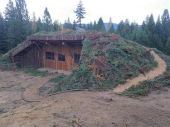Mariya Bee wrote:Thank you for sharing, Destiny. I was curious about a place like Liechtenstein. I'm open to do something abroad!
Liechtenstein is an old aristocracy holding/leftover. It is tiny, more a citystate then a country total area wise.
If you want somewhere in Europe (still the continent with the friendliest weather compared to every other continent), look into a country with more space, less population density, no brewing regional tensions (so balkans is out), enough water (leaves out most of the south / mediteranian countries due to big forest fires, serious heat, no rain for months and wells going dry). Italy is dry, earthquake risk and south is maffia with big say and esp. countryside. Spain / iberian peninsula is turning into desert (and water is for tourism on the coast and big ag.) Greece also dry + rocks, mountains so fertile soil is scarce. Balkans is somewhat like that + ongoing tensions between the various ethnic groups. Hungary has liberty issues, and the east is although cheap also dry, poor healthcare has difficulties, big business gets away with whatever (corruption issues) and Russia is being a pain (including badmouthing whatever getss the local population stirred up to keep the goverment busy internally ...
Some parts of France, Germany and the Alps (italian at least) have options due to empty rural hamlets, but bring money, skills and know what you may do yourself and what needs proof of skill for you to diy. Sometimes insurance may demand such, so will government grants for insulation and assorted energy saving measures. Now the empty rural thing also applies to spain, portugal and italy, but not all of those countries allow owner rebuild without proof of skill. And the cost of labour is like 80-95% of the work. Yes, you do need to know what you are doing, most likely it is old building techniques and those don't do well mixed with cement (and a lot of that was used in 80-90 to modernize them).
So, you need knowledge i.e. internet, because the locals may not know what modern stuff can be compatible building wise. Government with good rule of law and even if it is just in the community hall communication to the outside world. You isolate yourself, you make such a community very vulnarable to malice and greed. Not to mention no help from your neighbours where that is needed most. Countryside may be more distant houses wise, but working together is what keeps them all thriving. Even as a group you'll need help (and give it in return).
Now "isolated" often means mountains, so even without the no tech ideal forget about tractors and such, they'd tumble down the mountain. It also means different resources and if you want to be selfsustaining/self sufficient (i.e. no groceries/supermarket) you'll need a lot of land per person and adapt the diet to what food can be raised or grown. You may end up going dairy, meat, eggs and fruit/nuts over grains (needs flat-ish land) while herbivores do very well in this landscape where grazing up hill means heads are closer to the grass.
Also : there are plenty of people picking such environments when young, but find out that getting about on slopes becomes difficult with age. That means you either move to flatter terrain when you get older or your body limits your ability to get about. The locals won't have such problems because they grew up with it.
Your dream is lovely, but requiers young, healthy people to do and will come with a lot of wear and tear before 45. Minimizing tech and being critical of what and where to use it has merrit, but so does a washingmachine. There is a reason rural = big families, children are free labour from a fairly early age and by the time the parents start to creak (40-50) the oldest can pick up the slack. You step into such a system with few or no children, no conditoning for this kind of labour and a cohesion dependant on ideals rather then family habits you'll need compromises to last for any length of time.





